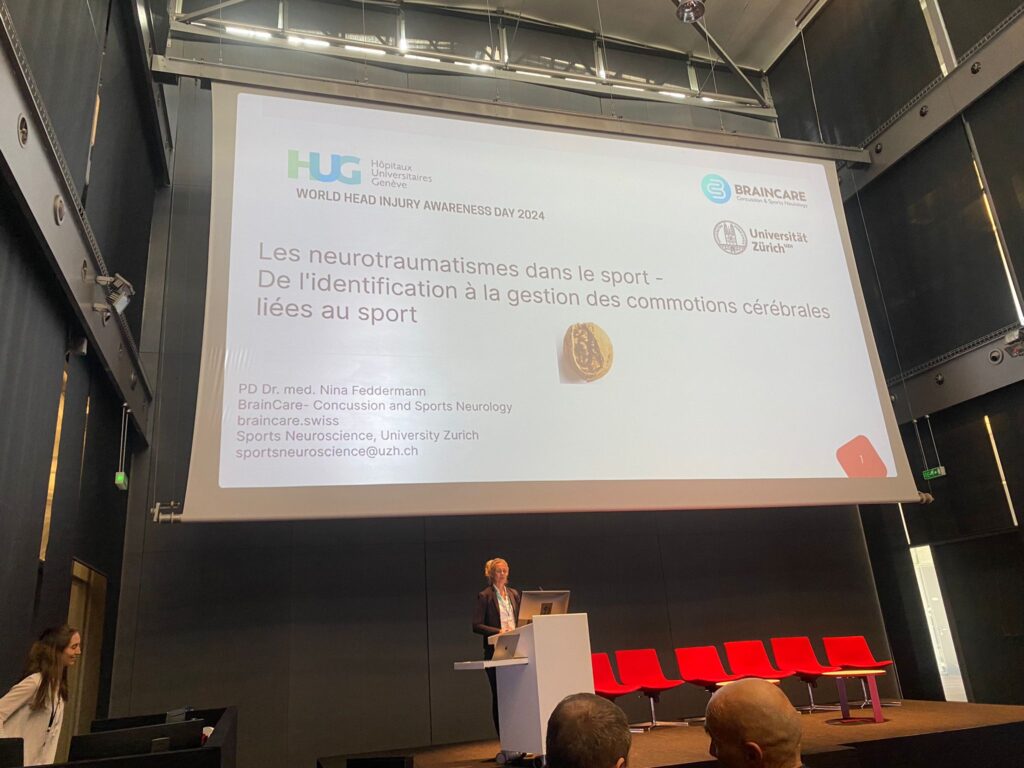End of March 2024, the medical and sports communities came together in Geneva for a groundbreaking event: the first World Head Injury Awareness Day (WHIAD), hosted by HUG at Campus Biotech. This pivotal gathering aimed to shine a light on the critical issues surrounding traumatic brain injuries (TBI), from prevention and treatment to the urgent need for research advancement.
Among the many insightful discussions, BrainCare’s own Nina Feddermann provided a compelling overviewon the diagnosis and management of sports-associated traumatic brain injuries. We are deeply thankful to the organizers for this opportunity, which allowed us to contribute significantly to the day’s conversations.

Our Personal Highlights and Key Takeaways:
The discussions at WHIAD illuminated several startling statistics and emphasized the need for a concerted global effort toward addressing TBI. Here are some of the key takeaways from the event:
– The Global Impact of TBI: Approximately 69 million individuals suffer a traumatic brain injury each year, which not only causes immense personal distress but also has a profound societal impact.
– Economic Burden: In Europe alone, the economic cost of TBI reaches an astonishing 400 billion annually.
– Loss of Life Years: Annually, 1.3 million life years are lost due to TBIs, underscoring the severe human cost of these injuries.
– Prevalence: The saying “everyone knows someone with a traumatic brain injury” reflects the widespread nature of TBI, highlighting its relevance in our communities.
– Common Symptoms: Fatigue, dizziness /vertigo, balance problems, headaches, irritability, and sleep disturbances are among the most frequently reported symptoms of TBI.
– The Necessity of Prevention: With societal changes, prevention has become even more critical. Approximately 47% of TBIs are due to falls, and a significant percentage result from various types of accidents, including traffic collisions.
– Long-term Effects: Over 30% of individuals with TBI experience persistent symptoms after one year, indicating the need for long-term care solutions.
– The Need for Multidisciplinary Clinics: Currently, there is a significant gap in care for TBI patients, as multidisciplinary clinics that can address the complex needs of these individuals are rare.
– Comprehensive Approach: Effective TBI management requires a blend of prevention, clinical care, and research.
– The Power of Collaboration: The event underscored the importance of collaborative, interdisciplinary research projects that bring together coaches, sports medicine professionals, neuroscientists, and other experts to further advance our understanding and treatment of TBI.
Looking Forward
The inaugural WHIAD was more than just a conference; it was a call to action for professionals across various disciplines to unite in the fight against traumatic brain injuries and their effects. The insights shared during the event have laid the groundwork for future advancements in prevention, treatment, and research.
As we reflect on the discussions and presentations, it’s clear that a multidisciplinary approach is crucial for addressing the complexities of TBI. By working collaboratively, we can develop more effective strategies for prevention, establish multidisciplinary clinics to provide comprehensive care, and push the boundaries of research to improve outcomes for individuals affected by TBI.
Let’s carry forward the momentum from WHIAD and work together to make a difference in the lives of those impacted by traumatic brain injuries. The journey has just begun, and the potential for positive change is immense.